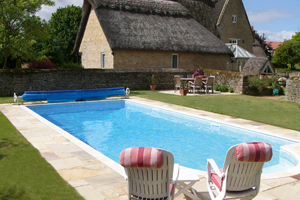


 In this article we will take a look at when and where planning permission might be required for your swimming pool.
In this article we will take a look at when and where planning permission might be required for your swimming pool.
The rules governing swimming pools.
In the UK, the rules that govern planning permission for swimming pools are the same ones that apply to sauna cabins, outbuildings, garden rooms and quite a few other structures.
These buildings are described as, ‘structures incidental to the enjoyment of the dwelling house’. So, buildings that allow you to enjoy living in your property more; which sounds like a good description of a swimming pool.
When planning permission will and won’t be required.
- Your swimming pool must be behind the building line if you want to avoid applying for planning permission. The ‘building line’ is a line that is drawn across your property by the front elevation of your house.
- If you were thinking of a pool house then it would need to be single storey with a maximum height at the eaves of 2.5 metres and maximum overall height of 4 metres with a dual pitched roof or 3 metres for any other roof. If you are going to build within 2 meters of your boundary, then the overall height must be less than 2.5 metres. Higher than that, permission will be required.
- No verandas, balconies or raised platforms if you want to avoid planning permission.
- You can’t build on more than half the area of land around your original house unless you apply for planning permission. The term “original house” means the house as it was first built or as it stood on 1 July 1948 (if it was built before that date). Although you may not have built an extension to the house, a previous owner may have done so.
- In National Parks, the Broads, Areas of Outstanding Natural Beauty and World Heritage Sites the maximum area your pool can cover is 10 square metres and if you want to build at the side of your house rather than the back, you will have to apply for planning permission.
- If you live in a listed building, your pool will require planning permission.
- If your pool would be overlooked by a public highway or would be nearer to that road, footpath or bridleway than any other part of your house, you may have to apply.
Building regulations.
Building regulations wouldn’t normally apply to an indoor pool as long as it is less than 30 square metres, has no sleeping accommodation and isn’t attached to your house.
However, the Government have proposed that indoor pools must conform to Part ‘L’ of the building regulations which concern insulation of the walls and floor.
If in doubt…
Planning permission is a complicated area and local authorities and councils quite often interpret the rules in slightly different ways and some regulations may vary so it may be a good idea to check with your local planning officer to make absolutely sure.
If you build without planning permission when it turns out that you needed it then you may have to demolish whatever has been built.
A local, professional pool contractor will know all about planning regulations and will know how they are applied in your area.
If you are looking for a pool builder, then we can help with that as well, just use the contact button at the top of this article and we can find someone with the appropriate skills and qualifications in your area.
There are many more articles on this site to help you with planning a new pool so, dive in.